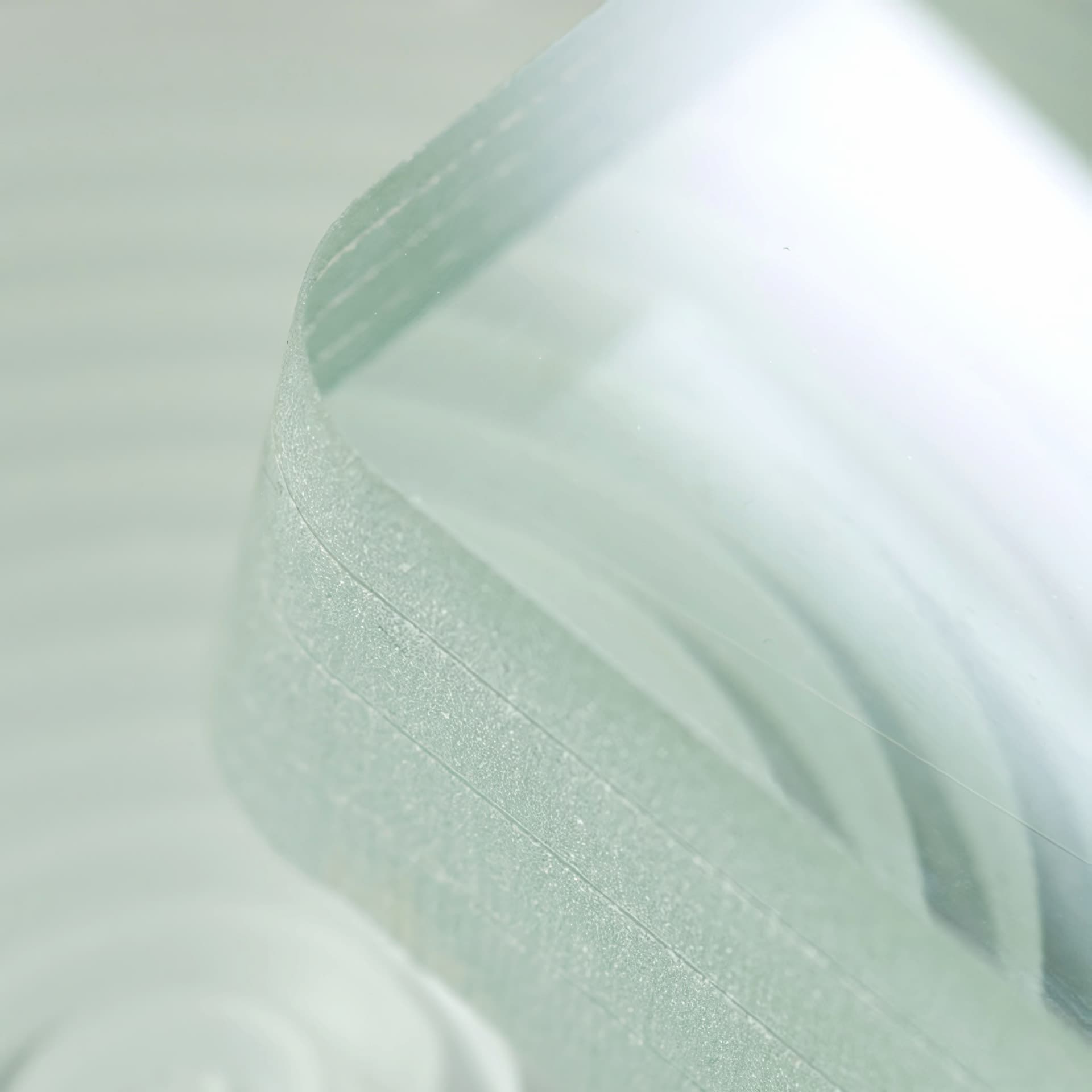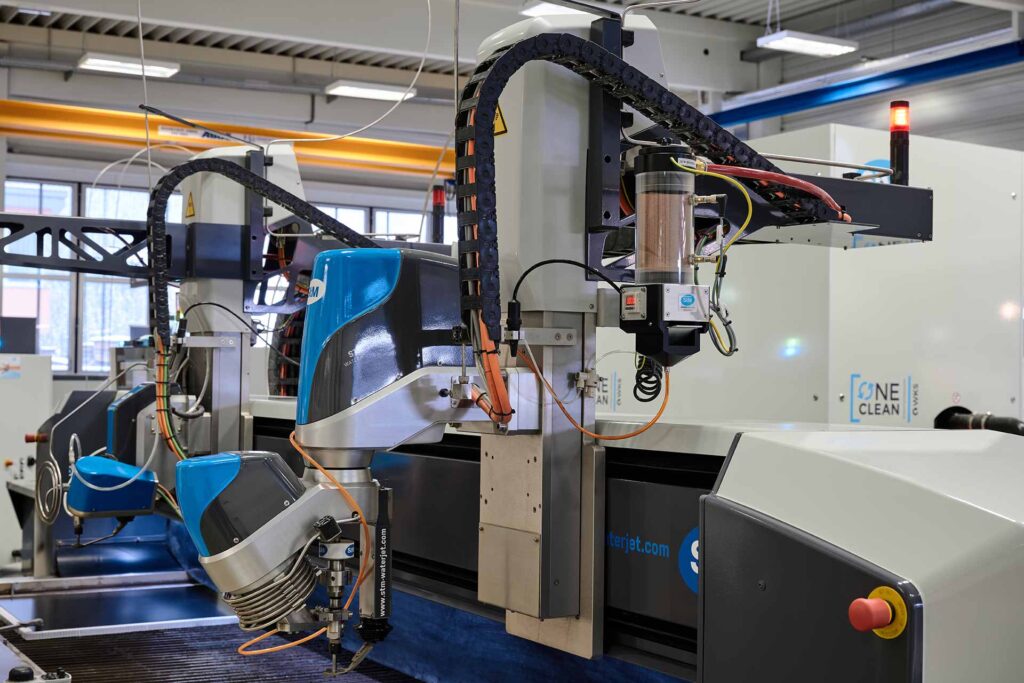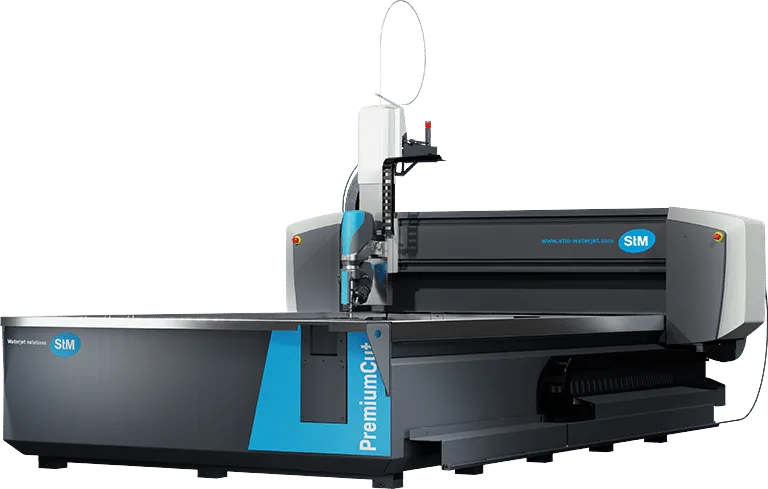Waterjet cutting glass
Flat glass, float glass, stained glass, glass tiles and more.
Waterjet cutting is a precise cutting process that is particularly well suited for cutting glass. It is a high-tech tool and is the first choice in terms of shape and dimensional accuracy, especially for curved glass contours.
A major advantage of waterjet cutting for glass is that the cutting process does not involve heat. As a result, the structure and properties of the glass remain unchanged, and there is no deformation or loss of material.
The process also enables precise cutting of glass types normally considered difficult to work with, and it is environmentally friendly because no harmful emissions are produced and the water can be recycled.
Table of contents
Table of contents
What types of glass can be cut?
Waterjet cutting can be used to cut different types of glass. It can precisely cut glass up to 200 mm thick, regardless of whether the glass is thinner or thicker and more fragile. The precise and cold cutting technique allows clean cut edges and preserves the original structure and strength of the glass.
- Float glass
- Glass tiles
- Plexiglas
- Glass panels
- Crystal glass
- Borosilicate glass
- Clear glass
- Mirror glass
Want more information about cutting glass with water?
5 advantages – waterjet cutting glass
Waterjet cutting of glass offers significant advantages: It enables the highest precision in the processing of glass materials, allowing complex shapes and fine details to be precisely implemented.
The gentle cutting process without heat generation leaves the structure and integrity of the glass unchanged, minimizing material loss. Versatile application extends from different types of glass, allowing flexibility in different areas.
Waterjet cutting of glass is an environmentally friendly process as it produces no toxic emissions and does not use chemical coolants. The low post-processing saves time and costs. Because of this, waterjet cutting is a preferred technology in numerous industries, such as the glass industry.
Technical details
Several technical details are of great importance in waterjet cutting of glass. These include the water pressure and volume flow, which affect the cutting speed and quality, as well as the selection and dosage of the abrasive for specific types of glass.
The right nozzle shape and size are crucial for the jet angle and the precision of the cutting process. Precise CNC control ensures the exact implementation of the desired cutting pattern, while the correct distance between the nozzle and the workpiece is important for an optimal cutting process. In addition, an efficient water purification system ensures sustainable reuse of water and contributes to the environmentally friendly nature of the process.
Modern waterjet cutting systems from STM offer many options for fine tuning and guarantee the highest precision and quality when cutting glass.
For thinner types of glass such as float glass, precise cuts can be made in thicknesses from 1 mm to about 10 mm. For thicker types of glass such as mirror glass or laminated glass, cuts up to a thickness of 100 mm or more may be possible.
Any shape cuts and bevel cuts up to 60° are possible.
The cutting accuracy is usually +/- 0.1 mm.
In waterjet cutting, the cut quality is basically divided into 5 quality levels.
- Separating cut Q1 (for blanks / semi-finished products)
- Standard cut Q3 (the most common cut)
- Fine cut Q5 (for optimum dimensional accuracy)
In waterjet cutting of glass, the achievable cutting speeds are usually in the range of 600 to 3000 mm per minute.
As a rule, the water pressure for glass processing is between 3600 and 4000 bar.
CNC control enables precise and repeatable cutting. The STM SmartCut cutting software offers high ease of use and functionality as well as flexibility.
References
The best advertising is known to be satisfied customers
Among our references you will find customers & partners from various fields. Among them are companies and facilities from the following industries:
- Metal industry
- Stone / Ceramics / Glass
- Plastics / foam industry
- Sealing industry
- Prototype / plant engineering
- Microwaterjet
- Educational Institutions
- Research
- Special materials
STM Product Finder
Find your work system – tailored to you
The individual wishes and requirements of our customers are the measure of all things for us. In order to be able to offer customized solutions for every requirement, we have developed a special product finder.
You tell us what you need to deliver perfect work and we put together the individual components and parts, as well as the associated software perfectly and individually. And if you are unsure, let your work material try our test cut.
FAQ – Frequently asked questions
The most frequently asked questions about waterjet cutting of glass
We have collected some FAQ on the topic, waterjet cutting of glass, and answered them succinctly for you.
If your question is not answered, please feel free to contact us directly.
Is waterjet cutting of glass safe?
Yes, waterjet cutting of glass is safe because the cutting process is cold and does not involve heat, minimizing the risk of cracks and fractures.
In addition, the precise CNC control enables accurate control of the cutting process, reducing the risk of errors or accidents.
What types of glass can be processed with waterjet cutting?
Various types of glass such as float glass, acrylic glass and more can be precisely cut with waterjet cutting. Both thinner glass for decorative applications and thicker glass for structural purposes can be cut using this technology.
How precise is waterjet cutting of glass?
Waterjet cutting offers high precision with tolerances in the range of a few tenths of a millimeter, enabling exact cuts and fine details. The precise cutting edge does not require additional finishing in most cases and ensures high quality of the end products.
Does waterjet cutting of glass cause cracks or stresses in the material?
No, because the cutting process does not involve heat, there are no cracks or stresses in the glass, maintaining the integrity of the material. This is especially important for delicate types of glass that might be damaged by other cutting methods. The cold-cutting nature of the process helps maintain the structural integrity of the glass and increases the life of the end products.
Is waterjet cutting of glass environmentally friendly?
Yes, waterjet cutting is environmentally friendly because it produces no toxic emissions and does not use chemical coolants. The water is often recycled, which reduces water consumption and makes the process more environmentally friendly overall.
What material thicknesses of glass can be cut with waterjet?
Waterjet cutting can cut glass in thicknesses from a few millimeters to a few centimeters or more, depending on the machine’s capabilities and the type of glass. Thinner types of glass can be cut precisely and without material loss, while thicker glass can be processed with higher pressure and adapted cutting parameters.
Is post-processing required after waterjet cutting of glass?
In most cases, no additional finishing is required because the cut edge in waterjet cutting of glass is cloudy, rough and precise. The high-quality cutting results minimize the need for manual rework, saving time and money. Nevertheless, depending on the specific application, a light polishing or edge finishing may be desired to achieve an even finer surface quality.
What glass can not be cut with a jet of water?
This depends on the hardness and type of material. Tempered glass (ESG – safety glass) will break due to the safety measure, this forces it to break into pieces by the force of the water jet.
Is a waterjet cutting the best solution for cutting glass?
Because of the controlled pressure and small jet size, waterjet cutting is the preferred option for many when cutting glass.


